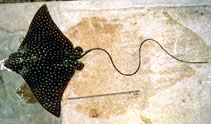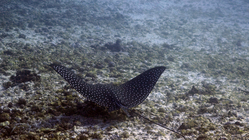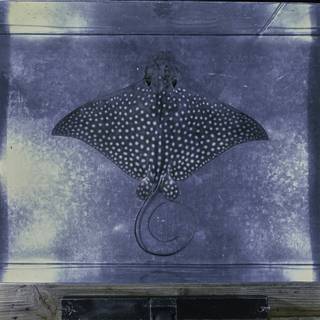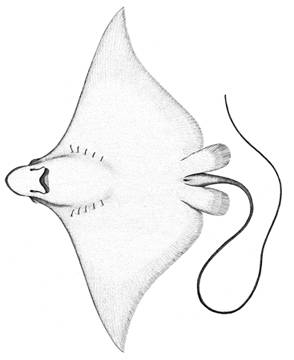WoRMS taxon details
Aetobatus narinari (Euphrasen, 1790)
217426 (urn:lsid:marinespecies.org:taxname:217426)
accepted
Species
Aetobates narinari (Euphrasen, 1790) · unaccepted (misspelling)
Aetobatis latirostris Duméril, 1861 · unaccepted
Aetobatis narinari (Euphrasen, 1790) · unaccepted (misspelling)
Raja narinari Euphrasen, 1790 · unaccepted
Stoasodon narinari (Euphrasen, 1790) · unaccepted
marine, brackish, fresh, terrestrial
Not documented
Description Usually found in shallow inshore waters. Common around bays, estuaries, off beaches and coral reefs but may cross oceanic...
Distribution N.C. (summer), Bermuda, se. Florida, and n. Gulf of Mexico to Brazil; nearly worldwide in tropical waters
Description Usually found in shallow inshore waters. Common around bays, estuaries, off beaches and coral reefs but may cross oceanic basins (Ref. 9862). Swims close to the surface, occasionally leaping out of the water, or close to the bottom (Ref. 3175). Frequently forms large schools during the nonbreeding season (Ref. 7251). Feeds mainly on bivalves but also eats shrimps, crabs, octopus and worms, whelks, and small fishes (Ref.9862). [details]
Distribution N.C. (summer), Bermuda, se. Florida, and n. Gulf of Mexico to Brazil; nearly worldwide in tropical waters
Distribution N.C. (summer), Bermuda, se. Florida, and n. Gulf of Mexico to Brazil; nearly worldwide in tropical waters [details]
Froese, R. and D. Pauly. Editors. (2024). FishBase. Aetobatus narinari (Euphrasen, 1790). Accessed through: World Register of Marine Species at: https://www.marinespecies.org/aphia.php?p=taxdetails&id=217426 on 2024-04-19
Date
action
by
![]() The webpage text is licensed under a Creative Commons Attribution-Noncommercial 4.0 License
The webpage text is licensed under a Creative Commons Attribution-Noncommercial 4.0 License
context source (HKRMS)
Hong Kong marine fish database. <em>AFCD.</em> , available online at https://www.hk-fish.net/en/fish/introduction/ [details]
context source (Bermuda) Smith-Vaniz, W. F.; Collette, B. B.; Luckhurst, B. E (1999). Fishes of Bermuda: History, zoogeography, annotated checklist, and identification keys (American Society of Ichthyologists and Herpetologists - Special Publication No.4) . ASIH, 424 pp. [details]
basis of record Froese, R. & D. Pauly (Editors). (2023). FishBase. World Wide Web electronic publication. version (02/2023)., available online at https://www.fishbase.org [details]
additional source McEachran, J. D. (2009). Fishes (Vertebrata: Pisces) of the Gulf of Mexico, Pp. 1223–1316 in: Felder, D.L. and D.K. Camp (eds.), Gulf of Mexico–Origins, Waters, and Biota. Biodiversity. Texas A&M Press, College Station, Texas. [details]
additional source Liu, J.Y. [Ruiyu] (ed.). (2008). Checklist of marine biota of China seas. <em>China Science Press.</em> 1267 pp. (look up in IMIS) [details] Available for editors [request]
[request]
ecology source Looby, A.; Erbe, C.; Bravo, S.; Cox, K.; Davies, H. L.; Di Iorio, L.; Jézéquel, Y.; Juanes, F.; Martin, C. W.; Mooney, T. A.; Radford, C.; Reynolds, L. K.; Rice, A. N.; Riera, A.; Rountree, R.; Spriel, B.; Stanley, J.; Vela, S.; Parsons, M. J. G. (2023). Global inventory of species categorized by known underwater sonifery. <em>Scientific Data.</em> 10(1). (look up in IMIS), available online at https://doi.org/10.1038/s41597-023-02745-4 [details]
context source (Bermuda) Smith-Vaniz, W. F.; Collette, B. B.; Luckhurst, B. E (1999). Fishes of Bermuda: History, zoogeography, annotated checklist, and identification keys (American Society of Ichthyologists and Herpetologists - Special Publication No.4) . ASIH, 424 pp. [details]
basis of record Froese, R. & D. Pauly (Editors). (2023). FishBase. World Wide Web electronic publication. version (02/2023)., available online at https://www.fishbase.org [details]
additional source McEachran, J. D. (2009). Fishes (Vertebrata: Pisces) of the Gulf of Mexico, Pp. 1223–1316 in: Felder, D.L. and D.K. Camp (eds.), Gulf of Mexico–Origins, Waters, and Biota. Biodiversity. Texas A&M Press, College Station, Texas. [details]
additional source Liu, J.Y. [Ruiyu] (ed.). (2008). Checklist of marine biota of China seas. <em>China Science Press.</em> 1267 pp. (look up in IMIS) [details] Available for editors
ecology source Looby, A.; Erbe, C.; Bravo, S.; Cox, K.; Davies, H. L.; Di Iorio, L.; Jézéquel, Y.; Juanes, F.; Martin, C. W.; Mooney, T. A.; Radford, C.; Reynolds, L. K.; Rice, A. N.; Riera, A.; Rountree, R.; Spriel, B.; Stanley, J.; Vela, S.; Parsons, M. J. G. (2023). Global inventory of species categorized by known underwater sonifery. <em>Scientific Data.</em> 10(1). (look up in IMIS), available online at https://doi.org/10.1038/s41597-023-02745-4 [details]
 Present
Present  Present in aphia/obis/gbif/idigbio
Present in aphia/obis/gbif/idigbio  Inaccurate
Inaccurate  Introduced: alien
Introduced: alien  Containing type locality
Containing type locality
From other sources
Description Usually found in shallow inshore waters. Common around bays, estuaries, off beaches and coral reefs but may cross oceanic basins (Ref. 9862). Swims close to the surface, occasionally leaping out of the water, or close to the bottom (Ref. 3175). Frequently forms large schools during the nonbreeding season (Ref. 7251). Feeds mainly on bivalves but also eats shrimps, crabs, octopus and worms, whelks, and small fishes (Ref.9862). [details]Distribution N.C. (summer), Bermuda, se. Florida, and n. Gulf of Mexico to Brazil; nearly worldwide in tropical waters [details]
Habitat nektonic [details]
| Language | Name | |
|---|---|---|
| English | whip morayspotted eagle ray | [details] |
| Japanese | マダラトビエイ | [details] |
| Spanish | chucho pintado | [details] |
To Barcode of Life (93 barcodes)
To Biodiversity Heritage Library (12 publications) (from synonym Aetobatis latirostris Duméril, 1861)
To Biodiversity Heritage Library (120 publications) (from synonym Aetobatis narinari (Euphrasen, 1790))
To Biodiversity Heritage Library (58 publications) (from synonym Raja narinari Euphrasen, 1790)
To Biodiversity Heritage Library (6 publications) (from synonym Aetobates narinari (Euphrasen, 1790))
To Biodiversity Heritage Library (76 publications) (from synonym Stoasodon narinari (Euphrasen, 1790))
To Biodiversity Heritage Library (81 publications)
To Biological Information System for Marine Life (BISMaL)
To Biological Information System for Marine Life (BISMaL) (from synonym Raja narinari Euphrasen, 1790)
To European Nucleotide Archive (ENA)
To FishBase (from synonym Stoasodon narinari (Euphrasen, 1790))
To FishBase
To FishBase (from synonym Raja narinari Euphrasen, 1790)
To FishBase (from synonym Aetobatis latirostris Duméril, 1861)
To FishBase (from synonym Aetobatis narinari (Euphrasen, 1790))
To FishBase (from synonym Aetobates narinari (Euphrasen, 1790))
To FishBase images (Aetobatus narinari, Brazil, by Vaske Jr., T.)
To GenBank (185 nucleotides; 154 proteins)
To GenBank (185 nucleotides; 154 proteins) (from synonym Raja narinari Euphrasen, 1790)
To Global Biotic Interactions (GloBI)
To IUCN Red List (Endangered)
To NMNH Extant Collection (Aetobatus narinari FIN031379 Slide 120 mm)
To NMNH Extant Collection (Aetobatus narinari P00284 illustration)
To ITIS
To Biodiversity Heritage Library (12 publications) (from synonym Aetobatis latirostris Duméril, 1861)
To Biodiversity Heritage Library (120 publications) (from synonym Aetobatis narinari (Euphrasen, 1790))
To Biodiversity Heritage Library (58 publications) (from synonym Raja narinari Euphrasen, 1790)
To Biodiversity Heritage Library (6 publications) (from synonym Aetobates narinari (Euphrasen, 1790))
To Biodiversity Heritage Library (76 publications) (from synonym Stoasodon narinari (Euphrasen, 1790))
To Biodiversity Heritage Library (81 publications)
To Biological Information System for Marine Life (BISMaL)
To Biological Information System for Marine Life (BISMaL) (from synonym Raja narinari Euphrasen, 1790)
To European Nucleotide Archive (ENA)
To FishBase (from synonym Stoasodon narinari (Euphrasen, 1790))
To FishBase
To FishBase (from synonym Raja narinari Euphrasen, 1790)
To FishBase (from synonym Aetobatis latirostris Duméril, 1861)
To FishBase (from synonym Aetobatis narinari (Euphrasen, 1790))
To FishBase (from synonym Aetobates narinari (Euphrasen, 1790))
To FishBase images (Aetobatus narinari, Brazil, by Vaske Jr., T.)
To GenBank (185 nucleotides; 154 proteins)
To GenBank (185 nucleotides; 154 proteins) (from synonym Raja narinari Euphrasen, 1790)
To Global Biotic Interactions (GloBI)
To IUCN Red List (Endangered)
To NMNH Extant Collection (Aetobatus narinari FIN031379 Slide 120 mm)
To NMNH Extant Collection (Aetobatus narinari P00284 illustration)
To ITIS




